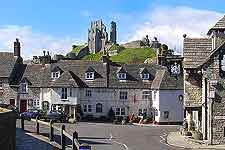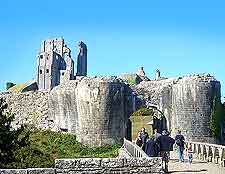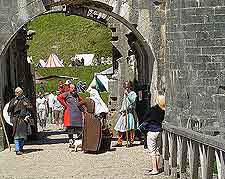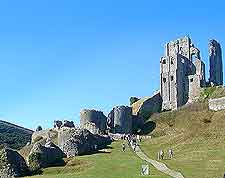Swanage Corfe Castle
(Swanage, Dorset, England, UK)

The ruins of Corfe Castle are still a very dramatic sight and dominate the village of the same name, standing high upon the top of a hill. Part of the English National Trust and just 8 km / 5 miles from both Swanage and Wareham, Corfe Castle is a major tourist attraction and offers an interesting history, which is explained in detail during the regular guided tours.
A busy road passes right next to Corfe Castle, meaning that these ancient battlements are a familiar sight with traffic headed to and from Swanage. Located alongside the road is a large car park (free to members of the National Trust) and also a visitors centre, with various exhibits, hands-on activities and a rather old-fashioned audio-visual display.

General Information
Completed during the latter part of the 11th century, the surrounding burial mounds suggest that there were people living in this area from as far back as the 6th century BC. Corfe Castle was built as a stronghold by the Normans, with some walls being as much as 9 metres / 30 feet thick, and replaced a far less imposing earlier wooden fortress.
It is believed that King Edward the Martyr was actually murdered on this very site in 978 AD by his stepmother, so that her son Ethelred 'The Unready' could rise to the throne.

Various improvements and additions were made to Corfe Castle by King John at the turn of the 13th century, when it was used as a prison and also as an extremely comfortable countryside royal residence. When King John arrived at Corfe Castle, the peasants living in makeshift tents beneath the hill were moved on and replaced by his royal court, which literally numbered thousands and included some 200 bodyguards and trained archers. During his visits, so many people came with King John that
London resembled something of a ghost town.
Between the 14th century and the 16th century, Corfe Castle become a far less used royal stronghold and began to fall into a state of disrepair. Queen Elizabeth I actually sold the castle to her Lord Chancellor, Sir Christopher Hatton, in 1572, when it was converted into a very luxurious home. In 1635, Sir John Bankes purchased Corfe Castle and after his death in the Civil War, his wife, Lady Mary Bankes, was left to defend the castle during a major siege in 1643. In 1646, parliamentarians led by Oliver Cromwell overthrew the royalists and used gunpowder to demolish the castle and create the ruins of today.

Part of the Bankes / Kingston Lacy estate, Corfe Castle was bequeathed to the National Trust by Ralph Bankes in the 1980s, when extensive conservation work was undertaken. Around 200,000 visitors now visit these ruins each year, with crowds of sightseers arriving during the summer months.
A National Trust shop and tearoom is close by and features a 1-20 scale model of the castle and villages, showing its appearance in the early 17th century.
Open hours: daily, November to February - 10:00 to 16:00; March and October - 10:00 to 17:00; April to September - 10:00 to 18:00
Admission: charge, discounts for children, seniors and families, free to members of the National Trust
 The ruins of Corfe Castle are still a very dramatic sight and dominate the village of the same name, standing high upon the top of a hill. Part of the English National Trust and just 8 km / 5 miles from both Swanage and Wareham, Corfe Castle is a major tourist attraction and offers an interesting history, which is explained in detail during the regular guided tours.
The ruins of Corfe Castle are still a very dramatic sight and dominate the village of the same name, standing high upon the top of a hill. Part of the English National Trust and just 8 km / 5 miles from both Swanage and Wareham, Corfe Castle is a major tourist attraction and offers an interesting history, which is explained in detail during the regular guided tours.
 Various improvements and additions were made to Corfe Castle by King John at the turn of the 13th century, when it was used as a prison and also as an extremely comfortable countryside royal residence. When King John arrived at Corfe Castle, the peasants living in makeshift tents beneath the hill were moved on and replaced by his royal court, which literally numbered thousands and included some 200 bodyguards and trained archers. During his visits, so many people came with King John that London resembled something of a ghost town.
Various improvements and additions were made to Corfe Castle by King John at the turn of the 13th century, when it was used as a prison and also as an extremely comfortable countryside royal residence. When King John arrived at Corfe Castle, the peasants living in makeshift tents beneath the hill were moved on and replaced by his royal court, which literally numbered thousands and included some 200 bodyguards and trained archers. During his visits, so many people came with King John that London resembled something of a ghost town. Part of the Bankes / Kingston Lacy estate, Corfe Castle was bequeathed to the National Trust by Ralph Bankes in the 1980s, when extensive conservation work was undertaken. Around 200,000 visitors now visit these ruins each year, with crowds of sightseers arriving during the summer months.
Part of the Bankes / Kingston Lacy estate, Corfe Castle was bequeathed to the National Trust by Ralph Bankes in the 1980s, when extensive conservation work was undertaken. Around 200,000 visitors now visit these ruins each year, with crowds of sightseers arriving during the summer months.